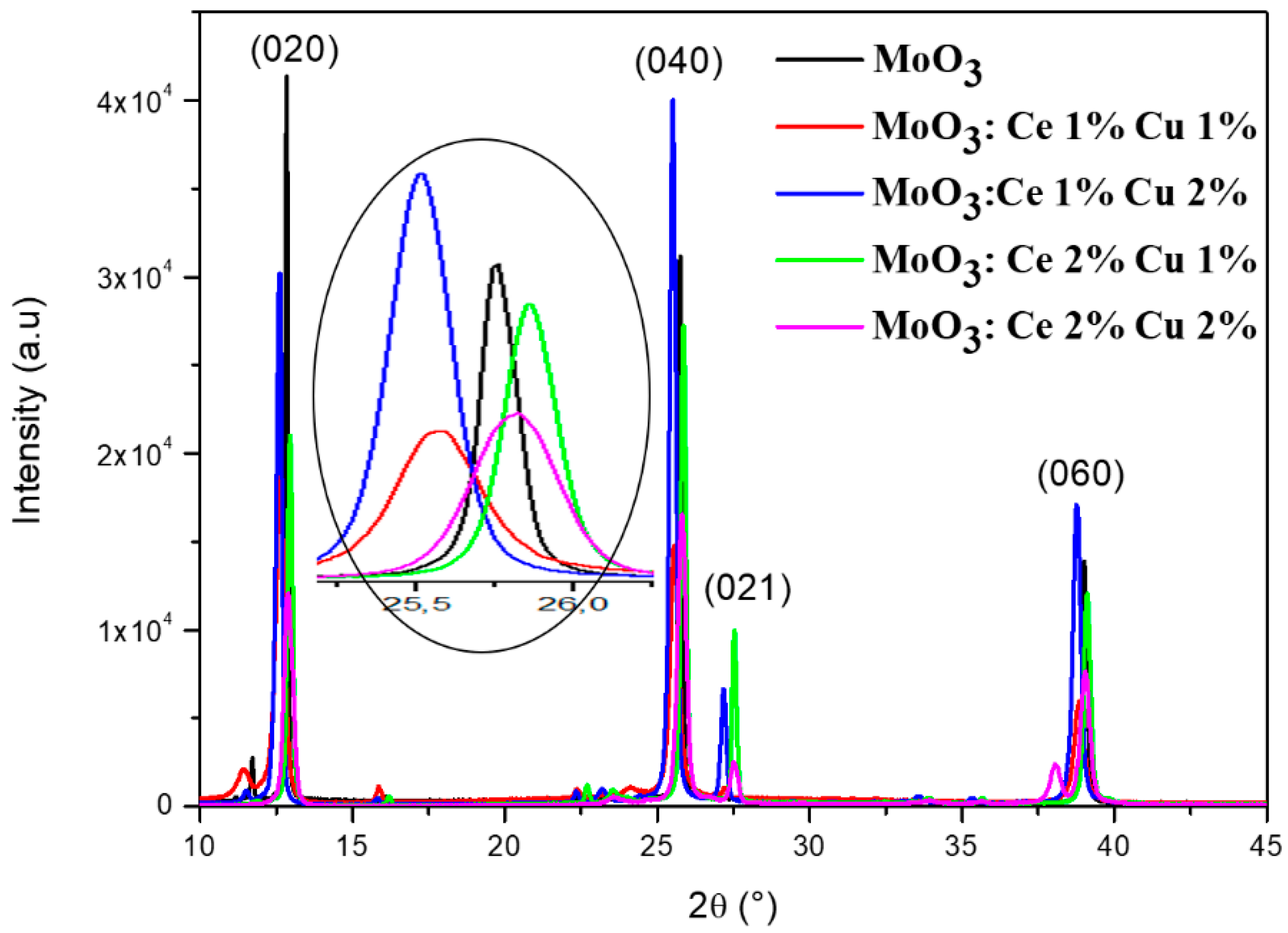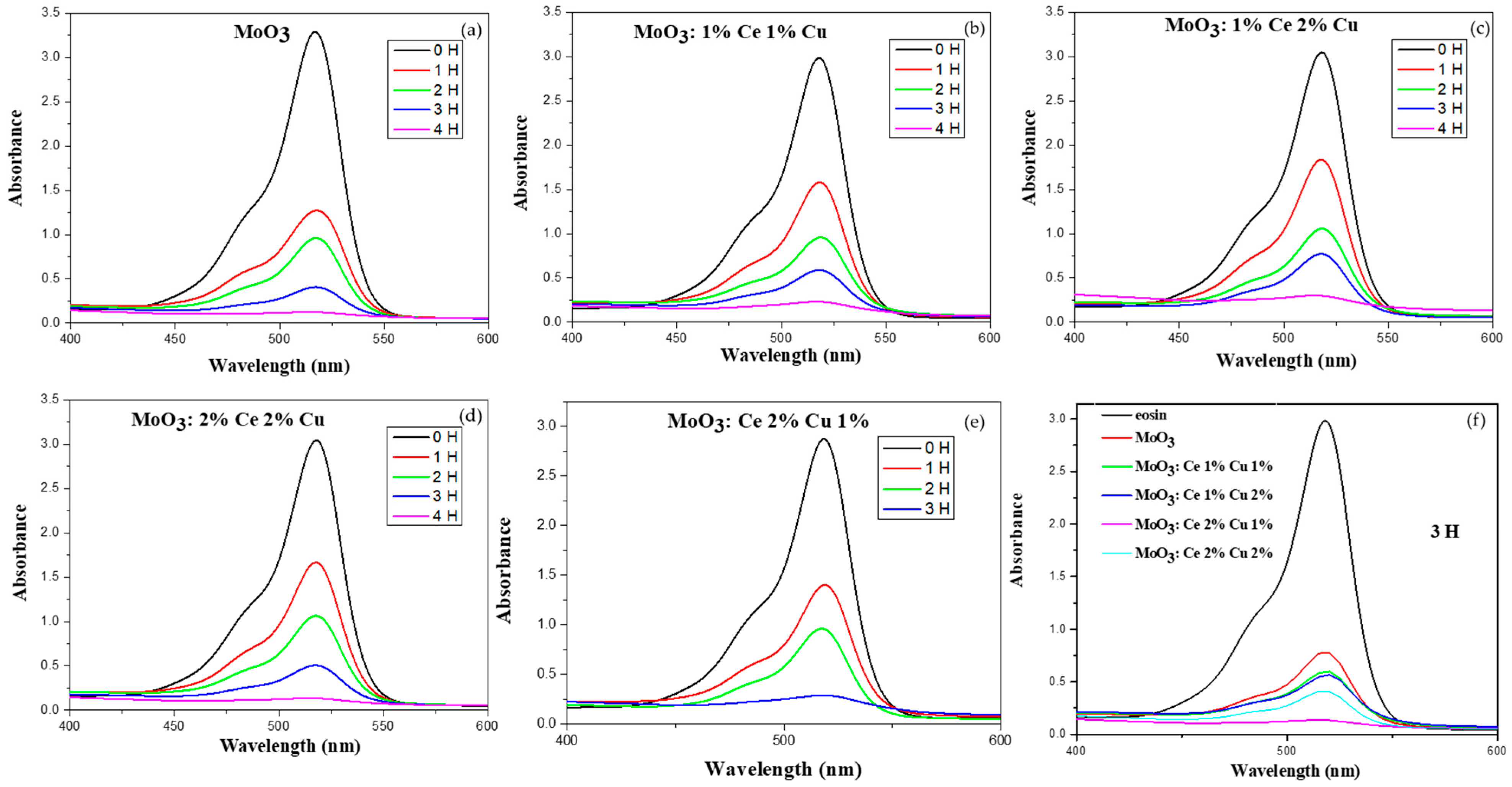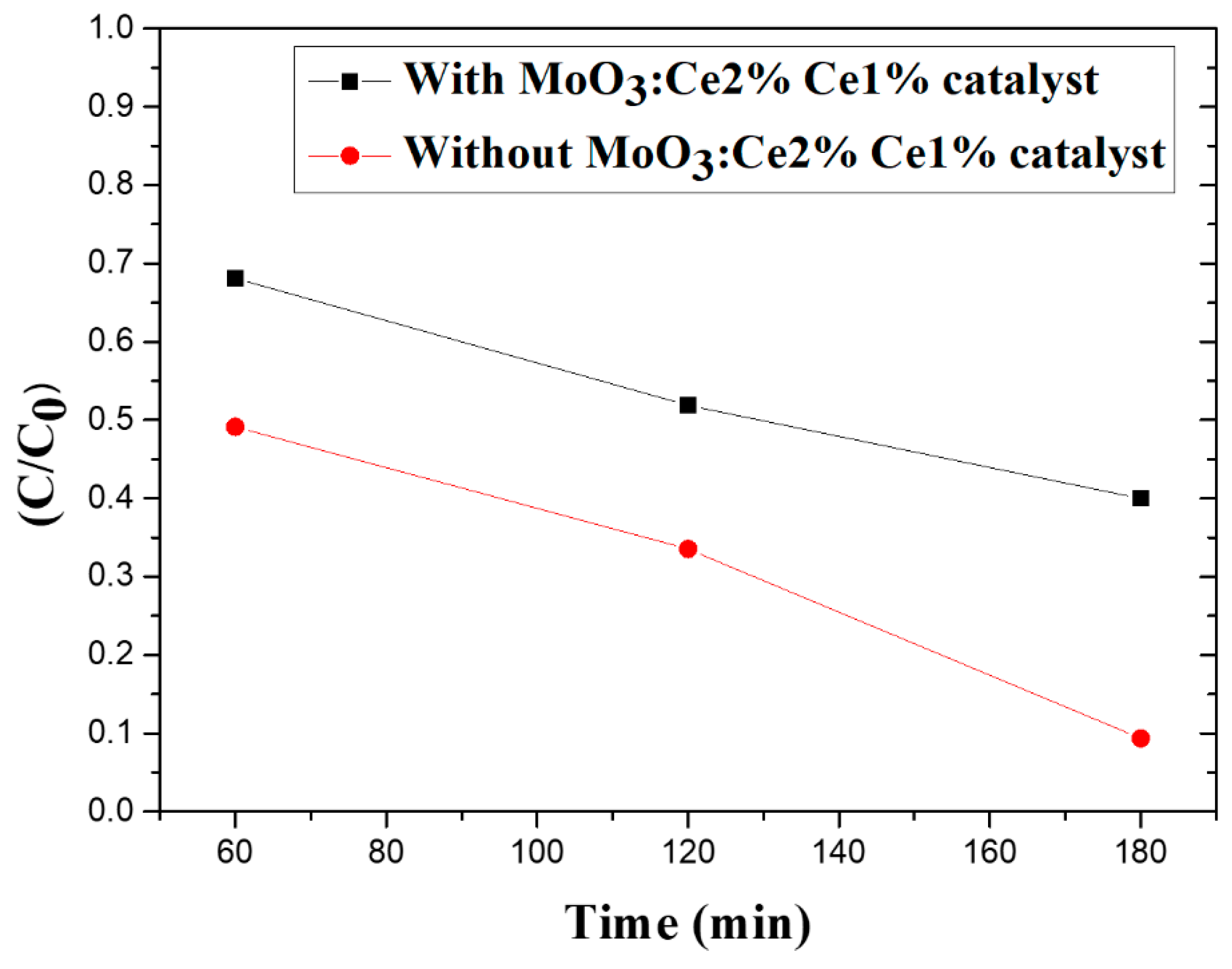Synthesis and Characterization of Highly Photocatalytic Active Ce and Cu Co-Doped Novel Spray Pyrolysis Developed MoO3 Films for Photocatalytic Degradation of Eosin-Y Dye
Abstract
:1. Introduction
2. Experimental Details
2.1. Ce-Cu-Doped MoO3 Thin-Film Deposition
2.2. Characterization Techniques
3. Results and Discussion
3.1. X-ray Diffraction Analysis
3.2. UV-DRS Spectroscopy
3.3. Photocatalytic Analysis
4. Conclusions
Author Contributions
Funding
Institutional Review Board Statement
Informed Consent Statement
Data Availability Statement
Conflicts of Interest
References
- Al Boukhari, J.; Zeidan, L.; Khalaf, A.; Awad, R. Synthesis, characterization, optical and magnetic properties of pure and Mn, Fe and Zn doped NiO nanoparticles. Chem. Phys. 2019, 516, 116–124. [Google Scholar] [CrossRef]
- Chen, Y.; Xu, M.; Wen, J.; Wan, Y.; Zhao, Q.; Cao, X.; Ding, Y.; Wang, Z.L.; Li, H.; Bian, Z. Selective recovery of precious metals through photocatalysis. Nat. Sustain. 2021, 4, 618–626. [Google Scholar] [CrossRef]
- Bahnemann, D. Photocatalytic water treatment: Solar energy applications. Sol. Energy 2004, 77, 445–459. [Google Scholar] [CrossRef]
- Ravelli, D.; Dondi, D.; Fagnoni, M.; Albini, A. Photocatalysis. A multi-faceted concept for green chemistry. Chem. Soc. Rev. 2009, 38, 1999–2011. [Google Scholar] [CrossRef]
- de Castro, I.A.; Datta, R.S.; Ou, J.Z.; Castellanos-Gomez, A.; Sriram, S.; Daeneke, T.; Kalantar-zadeh, K. Molybdenum Oxides—From Fundamentals to Functionality. Adv. Mater. 2017, 29, 1701619. [Google Scholar] [CrossRef]
- Ammar, I.; Gassoumi, A.; Akkari, A.; Delpech, F.; Ammar, S.; Turki-Kamoun, N. Deposition of SnS thin films by chemical bath deposition method: Effect of surfactants. Eur. Phys. J. Plus 2019, 134, 505. [Google Scholar] [CrossRef]
- Kamoun, O.; Gassoumi, A.; Kouass, S.; Alhalaili, B.; Vidu, R.; Turki-Kamoun, N. An Investigation on the Synthesis of Molybdenum Oxide and Its Silica Nanoparticle Composites for Dye Degradation. Nanomaterials 2020, 10, 2409. [Google Scholar] [CrossRef]
- Tomás, S.A.; Arvizu, M.A.; Zelaya-Angel, O.; Rodríguez, P. Effect of ZnSe doping on the photochromic and thermochromic properties of MoO3 thin films. Thin Solid Films 2009, 518, 1332–1336. [Google Scholar] [CrossRef]
- Pandeeswari, R.; Jeyaprakash, B.G. Nanostructured α-MoO3 thin film as a highly selective TMA sensor. Biosens. Bioelectron. 2014, 53, 182–186. [Google Scholar] [CrossRef]
- Pérez-González, M.; Morales-Luna, M.; Santoyo-Salazar, J.; Crotte-Ledesma, H.; García-Tinoco, P.E.; Tomás, S.A. Improved adsorption and photocatalytic removal of methylene blue by MoO3 thin films: Role of the sputtering power, film thickness, and sputtering working pressure. Catal. Today 2021, 360, 138–146. [Google Scholar] [CrossRef]
- Ghaleghafi, E.; Rahmani, M.B. Facile synthesis, characterization, and photoluminescence of lamellar α-MoO3 thin films. Solid State Sci. 2019, 94, 85–91. [Google Scholar] [CrossRef]
- Zhang, Y.; Ping, X.; Hao, L.; He, Y.; Guo, Y.; Zhao, Q.; Zheng, Z.; Lu, Y. Facile preparation of anodized MoO3−x films and their boosted photocatalytic activity. J. Environ. Chem. Eng. 2021, 9, 105565. [Google Scholar] [CrossRef]
- Al-Otaibi, A.L.; Ghrib, T.; Alqahtani, M.; Alharbi, M.A.; Hamdi, R.; Massoudi, I. Structural, optical and photocatalytic studies of Zn doped MoO3 nanobelts. Chem. Phys. 2019, 525, 110410. [Google Scholar] [CrossRef]
- Szkoda, M.; Trzciński, K.; Klein, M.; Siuzdak, K.; Lisowska-Oleksiak, A. The influence of photointercalaction and photochromism effects on the photocatalytic properties of electrochemically obtained maze-like MoO3 microstructures. Sep. Purif. Technol. 2018, 197, 382–387. [Google Scholar] [CrossRef]
- Arfaoui, A.; Touihri, S.; Mhamdi, A.; Labidi, A.; Manoubi, T. Structural, morphological, gas sensing and photocatalytic characterization of MoO3 and WO3 thin films prepared by the thermal vacuum evaporation technique. Appl. Surf. Sci. 2015, 357, 1089–1096. [Google Scholar] [CrossRef]
- Alex, K.V.; Jayakrishnan, A.R.; Ajeesh Kumar, S.; Ibrahim, A.S.; Kamakshi, K.; Silva, J.P.B.; Sekhar, K.C.; Gomes, M.J.M. Substrate temperature induced effect on microstructure, optical and photocatalytic activity of ultrasonic spray pyrolysis deposited MoO3 thin films. Mater. Res. Express 2019, 6, 066421. [Google Scholar] [CrossRef]
- Song, K.Y.; Park, M.K.; Kwon, Y.T.; Lee, H.W.; Chung, W.J.; Lee, W.I. Preparation of Transparent Particulate MoO3/TiO2 and WO3/TiO2 Films and Their Photocatalytic Properties. Chem. Mater. 2001, 13, 2349–2355. [Google Scholar] [CrossRef]
- Ponce-Mosso, M.; Pérez-González, M.; García-Tinoco, P.E.; Crotte-Ledesma, H.; Morales-Luna, M.; Tomás, A.S. Enhanced photocatalytic activity of amorphous MoO3 thin films deposited by rf reactive magnetron sputtering. Catal. Today 2020, 349, 150–158. [Google Scholar] [CrossRef]
- Gomathi, K.; Padmanathan, S.; Ali, A.M.; Rajamanickam, A.T. Construction of Ni doped MoO3 nanostructures and their application as counter electrode in dye-sensitized solar cells. Inorg. Chem. Commun. 2022, 135, 109079. [Google Scholar] [CrossRef]
- Kumar, A.; Prajapati, C.S.; Sahay, P.P. Results on the microstructural, optical and electrochromic properties of spray-deposited MoO3 thin films by the influence of W doping. Mater. Sci. Semicond. Process. 2019, 104, 104668. [Google Scholar] [CrossRef]
- Huang, L.; Xu, H.; Zhang, R.; Cheng, X.; Xia, J.; Xu, Y.; Li, H. Synthesis and characterization of g-C3N4/MoO3 photocatalyst with improved visible-light photoactivity. Appl. Surf. Sci. 2013, 283, 25–32. [Google Scholar] [CrossRef]
- Balaji, M.; Chandrasekaran, J.; Raja, M.; Marnadu, R. Impact of Cu concentration on the properties of spray coated Cu-MoO 3 thin films: Evaluation of n-CuMoO3/p-Si junction diodes by J-V, Norde and Cheung’s methods. Mater. Res. Express 2019, 6, 106404. [Google Scholar] [CrossRef]
- Benameur, N.; Chakhoum, M.A.; Boukhachem, A.; Dahamni, M.A.; Ghamnia, M.; Hacini, N.; Pireaux, J.P.; Houssiau, L.; Ziouche, A. Investigation of some physical properties of pure and Co-doped MoO3 synthesized on glass substrates by the spray pyrolysis method. J. Electron Spectrosc. Relat. Phenom. 2019, 234, 71–79. [Google Scholar] [CrossRef]
- Kamoun, O.; Mami, A.; Amara, M.A.; Vidu, R.; Amlouk, M. Nanostructured Fe,Co-codoped MoO3 thin films. Micromachines 2019, 10, 138. [Google Scholar] [CrossRef] [PubMed] [Green Version]
- Li, P.H.; Song, Z.Y.; Yang, M.; Chen, S.H.; Xiao, X.Y.; Duan, W.; Li, L.N.; Huang, X.J. Electrons in Oxygen Vacancies and Oxygen Atoms Activated by Ce3+/Ce4+ Promote High-Sensitive Electrochemical Detection of Pb(II) over Ce-Doped α-MoO3 Catalysts. Anal. Chem. 2020, 92, 16089–16096. [Google Scholar] [CrossRef] [PubMed]
- Giba, A.E.; Pigeat, P.; Bruyere, S.; Rinnert, H.; Soldera, F.; Mücklich, F.; Gago, R.; Horwat, D. Strong Room Temperature Blue Emission from Rapid Thermal Annealed Cerium-Doped Aluminum (Oxy)Nitride Thin Films. ACS Photonics 2017, 4, 1945–1953. [Google Scholar] [CrossRef]
- Ramarajan, R.; Kovendhan, M.; Thangaraju, K.; Joseph, D.P.; Babu, R.R.; Elumalai, V. Enhanced optical transparency and electrical conductivity of Ba and Sb co-doped SnO2 thin films. J. Alloys Compd. 2020, 823, 153709. [Google Scholar] [CrossRef]







| (hkl) | MoO3 | MoO3:Ce 1% Cu 1% | MoO3:Ce 1% Cu 2% | MoO3:Ce 2% Cu 1% | MoO3:Ce 2% Cu 2% |
|---|---|---|---|---|---|
| TC (020) | 1.92 | 1.90 | 1.23 | 1.22 | 0.77 |
| TC (040) | 1.44 | 1.50 | 1.69 | 1.54 | 0.25 |
| TC (021) | - | - | 0.27 | 0.56 | 1.74 |
| TC (060) | 0.64 | 0.60 | 0.71 | 0.68 | 1.24 |
| Samples | D (nm) | ε (10−4) | δdis (1014 Lines/m2) |
|---|---|---|---|
| MoO3 | 82.7 | 2.99 | 1.5 |
| MoO3:Ce 1% Cu 1% | 85.3 | 7.07 | 1.4 |
| MoO3:Ce 1% Cu 2% | 87.1 | 4.87 | 1.3 |
| MoO3:Ce 2% Cu 1% | 92.0 | 4.14 | 1.2 |
| MoO3:Ce 2% Cu 2% | 88.5 | 6.82 | 1.3 |
| Samples | Eg (eV) | Eu (meV) |
|---|---|---|
| MoO3 | 3.85 | 190 |
| MoO3:Ce 1% Cu 1% | 3.55 | 256 |
| MoO3:Ce 1% Cu 2% | 3.47 | 370 |
| MoO3:Ce 2% Cu 1% | 3.39 | 525 |
| MoO3:Ce 2% Cu 2% | 3.28 | 460 |
Publisher’s Note: MDPI stays neutral with regard to jurisdictional claims in published maps and institutional affiliations. |
© 2022 by the authors. Licensee MDPI, Basel, Switzerland. This article is an open access article distributed under the terms and conditions of the Creative Commons Attribution (CC BY) license (https://creativecommons.org/licenses/by/4.0/).
Share and Cite
Kamoun, O.; Gassoumi, A.; Shkir, M.; Gorji, N.E.; Turki-Kamoun, N. Synthesis and Characterization of Highly Photocatalytic Active Ce and Cu Co-Doped Novel Spray Pyrolysis Developed MoO3 Films for Photocatalytic Degradation of Eosin-Y Dye. Coatings 2022, 12, 823. https://doi.org/10.3390/coatings12060823
Kamoun O, Gassoumi A, Shkir M, Gorji NE, Turki-Kamoun N. Synthesis and Characterization of Highly Photocatalytic Active Ce and Cu Co-Doped Novel Spray Pyrolysis Developed MoO3 Films for Photocatalytic Degradation of Eosin-Y Dye. Coatings. 2022; 12(6):823. https://doi.org/10.3390/coatings12060823
Chicago/Turabian StyleKamoun, Olfa, Abdelaziz Gassoumi, Mohd. Shkir, Nima E. Gorji, and Najoua Turki-Kamoun. 2022. "Synthesis and Characterization of Highly Photocatalytic Active Ce and Cu Co-Doped Novel Spray Pyrolysis Developed MoO3 Films for Photocatalytic Degradation of Eosin-Y Dye" Coatings 12, no. 6: 823. https://doi.org/10.3390/coatings12060823
APA StyleKamoun, O., Gassoumi, A., Shkir, M., Gorji, N. E., & Turki-Kamoun, N. (2022). Synthesis and Characterization of Highly Photocatalytic Active Ce and Cu Co-Doped Novel Spray Pyrolysis Developed MoO3 Films for Photocatalytic Degradation of Eosin-Y Dye. Coatings, 12(6), 823. https://doi.org/10.3390/coatings12060823









